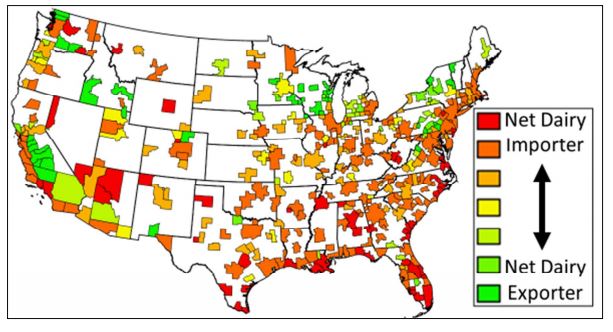News
NEW STUDY: Can Local Food Production Meet Household Demand? A Look at 377 US Metros
Many US metro areas already have capacity today to be fully self-sufficient for key food items. What does this mean for urban agriculture and the eat-local movement?
A new study from the University of Minnesota, recently published in the journal Environmental Science & Technology, evaluated current local capacity of 377 US metro areas to meet household demand for four specific food items- milk/dairy, eggs, fruit and vegetables through local agriculture in and around urban areas. Uniquely, the study measured the capacity for local agriculture today to meet both direct demand for these items (i.e., eggs, eaten as scrambled eggs and tomato eaten directly in a salad), as well as the embodied or indirect agrifood demand (i.e., eggs present in bread or pasta, and tomatoes in pasta sauce). For example, while a typical US household may consume 159 lbs pf dairy per year, it would consume almost four times as much (615 lbs) in raw milk equivalents when we look at all the food we eat that includes butter, cheese, yogurt and milk in a variety of food items.

Even when considering the larger direct-plus-embodied demand for these agrifood items, the study found that about one in five (20%) of all US Metro Areas already has enough urban agriculture occurring within its boundary to be fully self-reliant in milk and egg requirements, evaluated on an annual basis. About one in ten (10%) of all US Metro areas already have capacity to fully provide their homes with their fruit and vegetable requirements across the diet. These self-reliant metro areas are areas of high agricultural production of these items. For other urban areas that need to import agrifood, the median local capacity is about 5% – meaning most of these urban areas can supply about 5% of the full diet demand for items such as eggs, vegetables, and fruits.
When agriculture up to a radius of 100 miles outside urban metro areas is also included, the study found that the proportion of self-sufficient metros increases significantly to 53%, 67%, 18%, and 41% being capable, today, of meeting the full direct plus-embodied needs of their households of dairy-equivalents, eggs, fruits, and vegetables, respectively.
Further, if one focuses on just the fresh/direct demand portion of these items that are minimally processed, i.e. fluid milk, fresh eggs, as well as unprocessed apples and tomatoes, the study finds that even greater numbers of metropolitan areas already have capacity for self-reliance, with 69% self-sufficient in their direct fluid milk consumption, 85% self-sufficient in their unprocessed egg consumption, and 34% and 81% self-sufficient in fresh apple and tomato demand respectively.
These data mean that there is already substantial agriculture already happening in and around several metro regions, sufficient to support at least a significant chunk if not all household demand for these specific agrifood items. This is a new and significant finding given that the public media highlight international cities’ capacity for self-reliance, such as Singapore and Shanghai.
“Our study shows the issue is not that we lack agricultural production for these select items in and around US metro areas, but that our present-day supply chains may not be connecting local production and local demand”, says Peter Nixon, a PhD student in bioproducts and biosystems engineering who worked on this study.
Indeed, the results suggest that we should think carefully about what specific purposes increasing local agriculture in and around cities will serve – is it to boost the local economy, or to serve under-served communities? Other benefits such as heat island mitigation, social cohesion and improved quality of life from engaging with food and nature in cities, can also play a big role.
“It is really important to assess these co-benefits and understand who will benefit from increasing urban agriculture in cities, and how,” says Professor Anu Ramaswami, co-author and advisor on this study, “Our dataset can help individual urban areas understand their own particular situation with respect to production-demand for food as a starting point for further food systems planning.”




